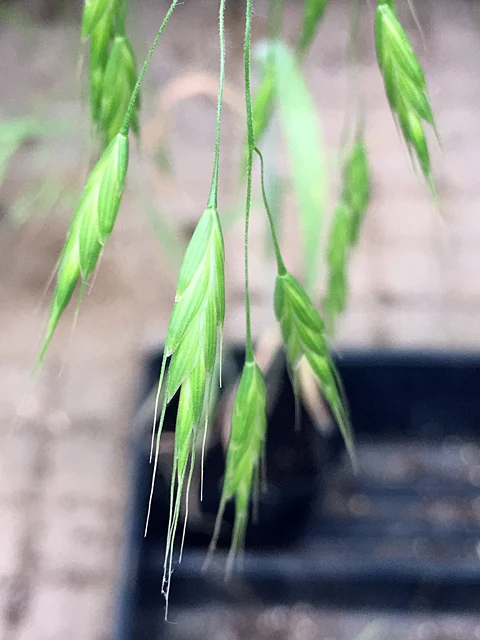June
When something unexpected shows up I greet it with guarded curiosity. I peered and poked at the newly appeared grass in the year-old savanna garden, appreciating its attractive features with enough skepticism to keep me on the hunt for its identity. In a last ditch attempt to narrow down the genus (Bromus) to a species, I pestered the hard working folks at Minnesota Wildflowers with an uploaded picture to their Facebook page. Three days later I had an ID, Cheatgrass, Bromus tectorum. You may have noticed the Bromes - medium height, cool season grasses whose often gracefully drooping flower arrives in late May to early July. There are many Bromes, many have been introduced to North America as forage grasses, and some are likely to be willing hybridizers.
Grass identification may be the perfect activity to teach the art of observation. Multiple points of focus are defined to aid grass identification, but most of these (too many parts, too many names, too small a detail...) induce a foggy brain and willful blindness. And, as any skilled observer knows, one day you're sharp and another blurred. Impatient, I pulled all brome grasses, concerned that they could also be Cheatgrass. To end this craze, I plucked one specimen out and potted it up, placing it in the greenhouse. If allowed to go to seed, I thought, I may be able to see the difference in the details.
As it went, close observation of the object, once detached from its environment, allowed me to see difference that I had been blind to. Cheatgrass, Bromus tectorum, has long awns -the long, thin, pointed thread extending from the lemma while other Bromus in my savanna plantings have short awns or none at all.
This trait now clear, I was able to distinguish Cheatgrass from the Prairie Brome (Kalm's Brome), above, I seeded and planted last summer. Unfortunately, my blindness had likely led to the removal of many Prairie Brome plants before I nailed down this difference.
Another tough identification was a new, singular plant with angular stem, tall stature, unusually-colored, small flowers that insects went wild for. Again, after being narrowed down by the folks at Minnesota Wildflowers, I could ID Early Figwort, Crophularia lanceolata, a potent pollinator attractant that is likely to return by self seeding.
This sloppy fellow caught my eye as it slowly climbed the remains of a Monarch-chomped Whorled Milkweed. I had seen several of these, earlier, at the base of irises and milkweeds being weeded in the front garden. Were they Japanese Beetle instars (but I hadn't seen these last year when there were so many JB) or had Colorado Potato Beetles finally discovered our potato patch (but there were no potatoes growing here, the eyes are black and the spots double on a potato beetle instar, plenty of which are available to see at a neighbors garden)?
This picture, uploaded to Bugguide, helped identify a large lady beetle-like insect I'd seen in May. Swamp Milkweed Beetle, Labidomera clivicollis, was a good fit -that's the plant on which the beetles had been hosted. Further clicking led to an image of its instar -an exact match of my juicy milkweed climber.
When transplanting from another garden, especially one untended by a gardener, and doubly so when the specimen is surrounded by invasive Goutweed, Aegopodium podagraria, it isn't wise to plant with its original root ball soil. Several aggressively-spreading plants intertwine their roots or rhizomes with the roots of our favored plants and the strategy ensures their persistence by creating a home base for developing roots and shoots safely hidden beneath your favorite garden plants.
If you do rescue something, like this large Cimicifuga, from an invasive patch about to be sprayed with glyphosate, use a hose to spray out all soil from the root mass, combing through for anything that looks like it belongs to the weed you don't want to introduce. The roots, above, only partially cleared of soil, show an entangled rhizome of the offending Aegopodium -small, but enough to regenerate. Before I planted it, I thoroughly washed away any remaining soil, then disposed any foreign root or rhizome. Despite my effort, I question my choice to remove a plant so crowded by goutweed for planting at our place (although Aegopodium does already exist in our woods, introduced accidentally or planted I cannot say).
In other news, lots of ticks in the garlic plots.











Comments
Post a Comment
Go ahead and comment! I will moderate and delete the spam. Thx